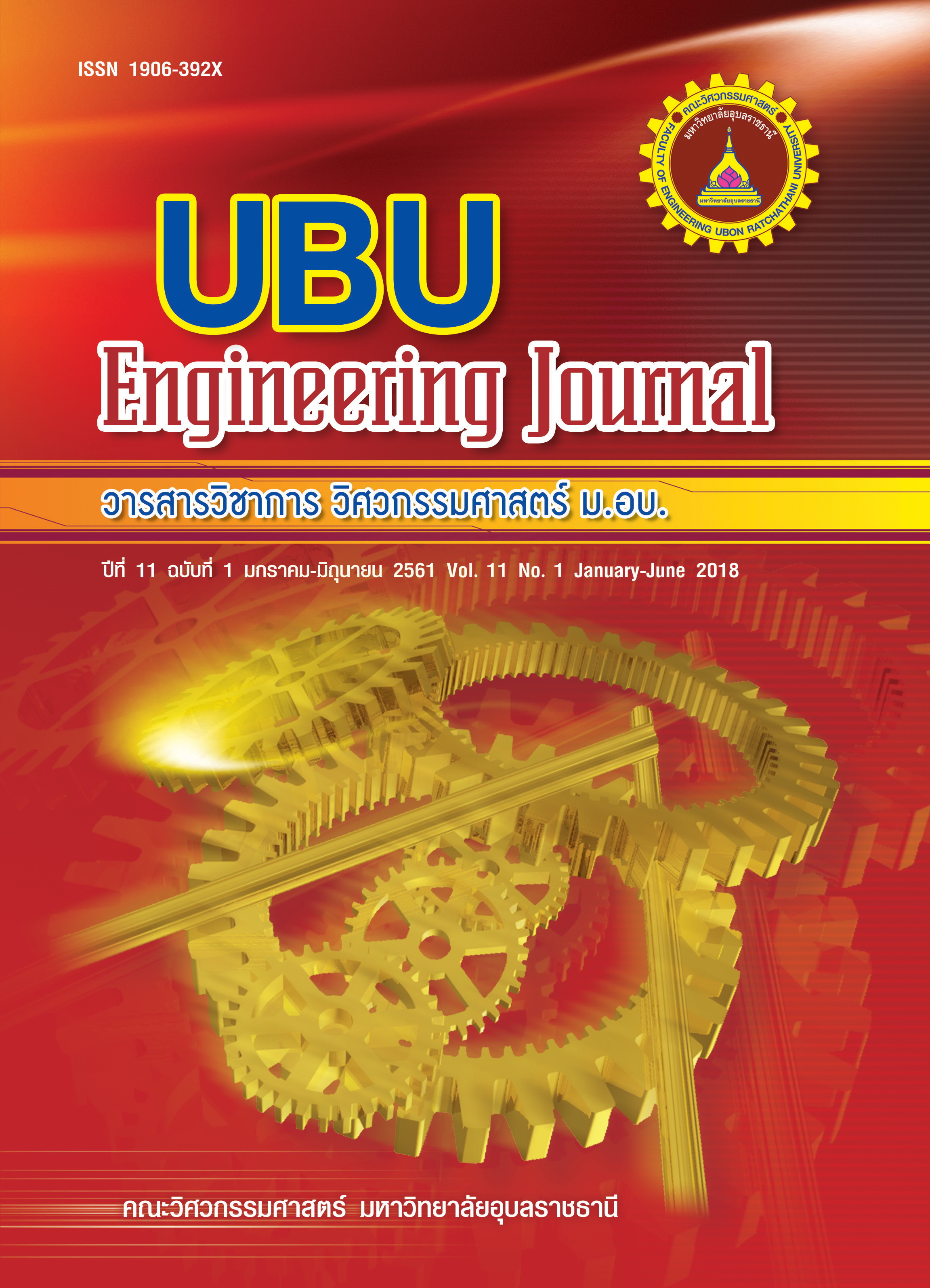ผลกระทบของสารช่วยผสานที่มีต่อสมบัติทางกลและสมบัติทางกายภาพของคอมโพสิต พอลิโพรพิลีนผสมกากกาแฟ
Main Article Content
Abstract
This research aimed to investigate the mechanical properties, and physical properties of spent coffee ground (SCG) filled polypropylene composites with different types of the compatibilizer for new product development. The compatibilizer in this research including vinyl trimethoxy silane (VTMS), 3-aminopropyl triethoxy silane (3-ATS) and polypropylene grafted maleic anhydride (PP-g-MA). Compounding by twin screw extruder and specimen prepared by Hot compression process. Properties measurement such tensile properties, impact strength, hardness, melt flow index and heat deflections temperature (HDT) and morphology investigation was performed. The result shows that PP/SCG composite containing VTMS was presenting the highest tensile strength, modulus and HDT. While PP-g-MA was the most efficient compatibilizer to better the Impact strength and hardness of PP/SCG-MA composite. Morphology investigation of fracture surface found that VTMS and PP-g-MA enhance adhesion between polypropylene and SCG. Finally, PP/SCG-MA composite be appropriate for packaging product.
Article Details
References
[2] Khaliq M, Azman H, Aznizam AB. Tensile, Oxygen Barrier and Biodegradation Properties of Rice Husk-Reinforced Polyethylene Blown Films. Agricultural Biomass Based Potential Materials. 2015: 143−154.
[3] Janusz D, Patrycja K. Effect of kenaf fibre modification on morphology and mechanical properties of thermoplastic polyurethane materials. Industrial Crops and Products. 2015; 74: 566–576.
[4] สำนักหอสมุดกลาง มหาวิทยาลัยรามคำแหง. บทบาทของกาแฟในสังคมมนุษย์ และคุณสมบัติของกาแฟในฐานะสมุนไพร. เข้าถึงได้จาก: https://www.lib.ru.ac.th
/journal/about_coffee02.html [เข้าถึงเมื่อ 22 เมษายน 2559].
[5] เจริญพร ถาวรประเสริฐ, ธนัชชา สุวรรณวิภากร, พิชัย เอี่ยวเล็ก, กฤช สมนึก. การศึกษากระบวนการสกัดน้ำมันจากกากกาแฟด้วยตัวทำละลายและระยะเวลาสกัด. ใน การประชุมวิชาการ วิศวกรรมเกษตรแห่งประเทศไทยระดับชาติ ครั้งที่ 16, 17–19 มีนาคม, กรุงเทพฯ. ประเทศไทย: 2558. p. 390–392.
[6] พรพรรณ แสนภูมิ, มนัสนันท์ นพรัตน์ไมตรี, สุภาวดี ฉิมทอง. การปรับปรุงกากกาแฟด้วยเอนไซม์เพื่อใช้เป็นพรีไบโอติกส์ในอาหารสัตว์. คณะสัตวศาสตร์และเทคโนโลยีการเกษตร, มหาวิทยาลัยศิลปากร; 2558.
[7] นพพร สุดใจธรรม. เชื้อเพลิงอัดแท่งจากกากกาแฟ. สาขาเทคโนโลยีที่เหมาะสมเพื่อการพัฒนาทรัพยากร, วิทยาศาสตรมหาบัณฑิต, มหาวิทยาลัยมหิดล; 2546.
[8] วันทนา นาคีสินธ์. การใช้กากกาแฟแทนขี้เลื้อยในการเพาะเห็ดนางรมฮังการี. สาขาสาขาวิทยาศาสตร์สิ่งแวดล้อม, วิทยาศาสตรมหาบัณฑิต, มหาวิทยาลัยศิลปากร; 2556.
[9] Rocio CV, Guadalupe LP, Hayde A, Casta~nedac V, Oomah DB. Spent coffee grounds: A review on current research and future prospects. Trends in Food Science & Technology. 2015; 54: 24−36.
[10] Lee HK, Young GP, Taikyeong J, Young SS. Green nanocomposites filled with spent coffee grounds. Journal of Applied Polymer Science. 2015; 132(23).
[11] Wu CS. Renewable resource-based green composites of surface-treated spent coffee grounds and polylactide: Characterisation and biodegradability. Polymer Degradation and Stability. 2015; 121: 51−59.
[12] Kelen CR, et al. Particles of Coffee Wastes as Reinforcement in Polyhydroxybutyrate (PHB) Based Composites. Materials Research. 2015; 18(3): 546−552.
[13] García-García D, Carbonell A, Samper MD, García-Sanoguera D, Balart R. Green composites based on polypropylene matrix and hydrophobized spent coffee ground (SCG) powder. Composites Part B. 2015; 78: 256−265.
[14] NABI SD, JOG JP. Natural Fiber Polymer Composites: A Review. Advances in Polymer Technology. 1999; 18(4): 351–363.
[15] ศูนย์เทคโนโลยีโลหะและวัสดุแห่งชาติ. พลาสติก-ประเภทและการใช้งาน. เข้าถึงได้จาก: https://www2.mtec.or.th/th/special/biodegradable_plastic/type_and_usage_plas.html [เข้าถึงเมื่อ 7 พฤษภาคม 2559].
[16] Yanling W, Rongrong Q, Xiong C, Huang M. Effects of Coupling Agent and Interfacial Modifiers on Mechanical Properties of Poly (lactic acid) and Wood Flour Biocomposites. Iranian Polymer Journal. 2011; 20(4): 281–294.
[17] Shanshan L, Haiyan T, Jiyou G, Yanhua Z. Silane Modified Wood Flour Blended with Poly (lactic acid) and its Effects on Composite Performance. Bio Resources. 2015; 10(3): 5426–5439.
[18] Fang L, Liang C, Guo W, Yongping C, Wang Z. Influence of silane surface modification of veneer on interfacialadhesion of wood–plastic plywood. Applied Surface Science. 2014; 288: 682–689.
[19] Benttini HPS, Bonse CB, Melo AE, Munoz ARP. Effect of sawdust surface treatment and compatibilizer addition on mechanical behavior, morphology, and moisture uptake of polypropylene/sawdust composites. Polymer engineering and science. 2009; 50(5): 978–985.
[20] Benttini HPS, Bonse CB, Melo AE, Munoz ARP. Effect of Sawdust Surface Treatment and Compatibillzer Addition on Mechanical Behavior, Morphology, and Moisture Uptake of Polypropylene/Sawdust Composites. Polymer Engineering and science. 2010; 50(5): 978–985.
[21] Kim HS, Lee BH, Choi SW, Kim S, Kim HJ. The effect of types of maleic anhydride-grafted polypropylene (MAPP) on the interfacial adhesion properties of bio-flour-filled polypropylene composites. Composites Part A: Applied Science and Manufacturing. 2007; 38: 1473–1482.
[22] Yang HS, Kim HJ, Son J, Park HJ, Lee BJ, Hwang TS. Rice-husk flour filled polypropylene composites; mechanical and morphological study. Composite Structures. 2004; 63: 305–312.
[23] Kwona JH, et al. Tensile properties of kenaf fiber and corn husk flour reinforced poly (lactic acid) hybrid bio-composites: Role of aspect ratio of natural fibers. Composites: Part B. 2014; 56: 232–237.
[24] Nunesa GS, et al. Study of Composites Produced with Recovered Polypropylene and Piassava. Materials Research. 2017; 20(1): 144–150.
[25] Yang S, Hyun JK, Hee JP, Bum LJ, Taek SH. Effect of compatibilizing agents on rice-husk flour reinforced polypropylene composites. Composite Structures. 2007; 77: 45–55.
[26] Sajid A, Sabu T. Polymers for Packaging Applications. Canada: Apple Academic Press; 2014.

